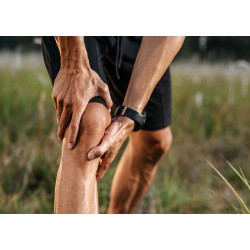DOCTOR INFORMATION
Ankle and foot examination (OSCE)
Introduction
- Greet the patient and introduce yourself
- Confirm patient details ✍
- Briefly explain the procedure in a patient friendly manner
- Get patient consent ✍
- Ask the patient to stand
- Wash hands ✋
- Check the patient is not in any pain
Look
Identify any clinically relevant signs:
👣 Scars: prior surgery on the lower limbs
👣 Obesity: causes joint pathology
👣 Muscle wastage: due to joint pathology or lower motor neuron injury
Identify any object or equipment that may be clinically relevant:
👣 Mobility aids: can indicate ankle and foot pathology ♿
👣 Prescriptions: can indicate recent medications 💊
Gait inspection 🚶:
👣 Gait cycle: record abnormalities
👣 Leg length: record abnormalities which may be caused by joint pathology
👣 Step height: high is associated with foot drop, caused by peroneal nerve palsy
👣 Limping: indicates joint pain/ weakness
👣 Turning: slow turning due to restrictions caused by joint disease
👣 Movement range: reduced by chronic joint pathology
👣 Difficulty tiptoeing: due to weakness of the lower limb muscles and arthritis
Normal gait cycle:
- Heel makes contact with floor
- Foot becomes flat and weight is transferred onto it
- Weight balanced on flat foot’s leg
- Heel lifted off floor
- Toes lifted off floor
- Foot swings forward and cycle begins again
Inspect ankle/ feet from anterior aspect to identify:
👣 Swelling: identify if unilateral
👣 Bruises: indicates trauma/spontaneous hemarthrosis
👣 Scars: prior surgery
👣 Calluses: thickened, hardened skin due to abnormal gait/ badly fitted shoes
👣 Psoriasis: associated with psoriatic arthritis
👣 Misaligned big toe
👣 Toe deformity: hammer toe/mallet toe
Inspect ankle/feet from a lateral aspect:
👣 Foot arch: identify flat feet/ abnormally arched foot
Inspect feet/ankle from a posterior aspect:
👣 Muscle wastage: indicates lower motor neuron lesion on disuse atrophy
👣 Achilles tendon: tendonitis/rupture
👣 Scars: prior surgery/trauma
👣 Misaligned heel: valgus/varus ankle joint deformity

Feel
Assess temperature 🌡:
- Use the back of your hands to assess the angle joint and foot temperature comparatively
- If the ankle joint is warmer and is also swollen and tender, suggests septic arthritis or inflammatory arthritis
Posterior tibial pulse:
👣 Situated behind the medial malleolus of the tibia
👣 Palpate for presence and compare the strength of the pulses between the 2 feet
Dorsalis pedis pulse:
👣 Situated over the dorsum in the foot, laterally to the extensor hallucis longus tendon, and over the 2ndand 3rd cuneiform bones
👣 Palpate for presence and compare strength of pulses between the 2 feet
Squeeze the metatarsophalangeal joints:
👣 Do so gently, and asses if the patient experiences any discomfort
👣 Tenderness indicates active inflammatory arthropathy
Palpate the ankle joints and foot:
Make a note of any swelling, tenderness or irregularity ✍:
👣 Distal fibula
👣 Calcaneum
👣 Tarsal joint
👣 Ankle joint
👣 Metatarsal and tarsal bones
👣 Medial/lateral malleoli
Palpate the Achilles tendon and the gastrocnemius muscle:
👣 Identify focal tenderness/ swelling suggesting tendonitis
👣 Identify any tendon discontinuity suggesting rupture
Move
Assess both active and then passive movement:
👣 Active movement: independently controlled movements
👣 Passive movement: clinician-controlled movement
Active and passive:
👣 Foot plantarflexion (0-50°): press foot down like using a car pedal 📐
👣 Foot dorsiflexion (0-20°): point feet to head 📐
👣 Toe flexion: curl toes as tightly as possible
👣 Toe extension: point toes to head
👣 Ankle/foot inversion (0-35°): put soles together 📐
👣 Ankle/foot eversion (0-15°): point soles as far outwards as possible 📐
Passive:
👣 Subtalar joint
👣 Midtarsal joint
Special Tests
Simmonds test to identify ruptured Achilles tendon:
- Ask the patient to kneel on a chair so that their feet are hanging at the edge
- Squeeze each calf, one at a time
- Feet should plantarflex
- No plantarflex suggests the Achilles tendon is ruptured
Completion
- Explain you have now finished the examination
- Thank patient
- Wash hands ✋
- Summarise what the examination revealed ✍
Summary:
- Greet the patient and briefly explain the examination
- Inspect the patient to identify anything clinically relevant
- Inspect the patient's gait cycle
- Inspect the patient's ankle/feet from an anterior, lateral and posterior aspect
- Assess the temperature of the patient's feet/ankle, and the posterior tibial/dorsalis pedis pulse
- Squeeze the metatarosophalangeal joints
- Palpate the ankle joints and foot, the achilles tendon, and the gastrocnemius muscle
- Assess the active and passive movement of the foot/ankle
- Perform Simmond's test to identify ruptured Achilles tendon
- Complete the procedure by thanking the patient
Related Articles
This step by step guide is designed to take you through the knee examination in OSCEs.
This step by step guide is designed to take you through the GALS examination in OSCEs.






-250x250.jpg)








